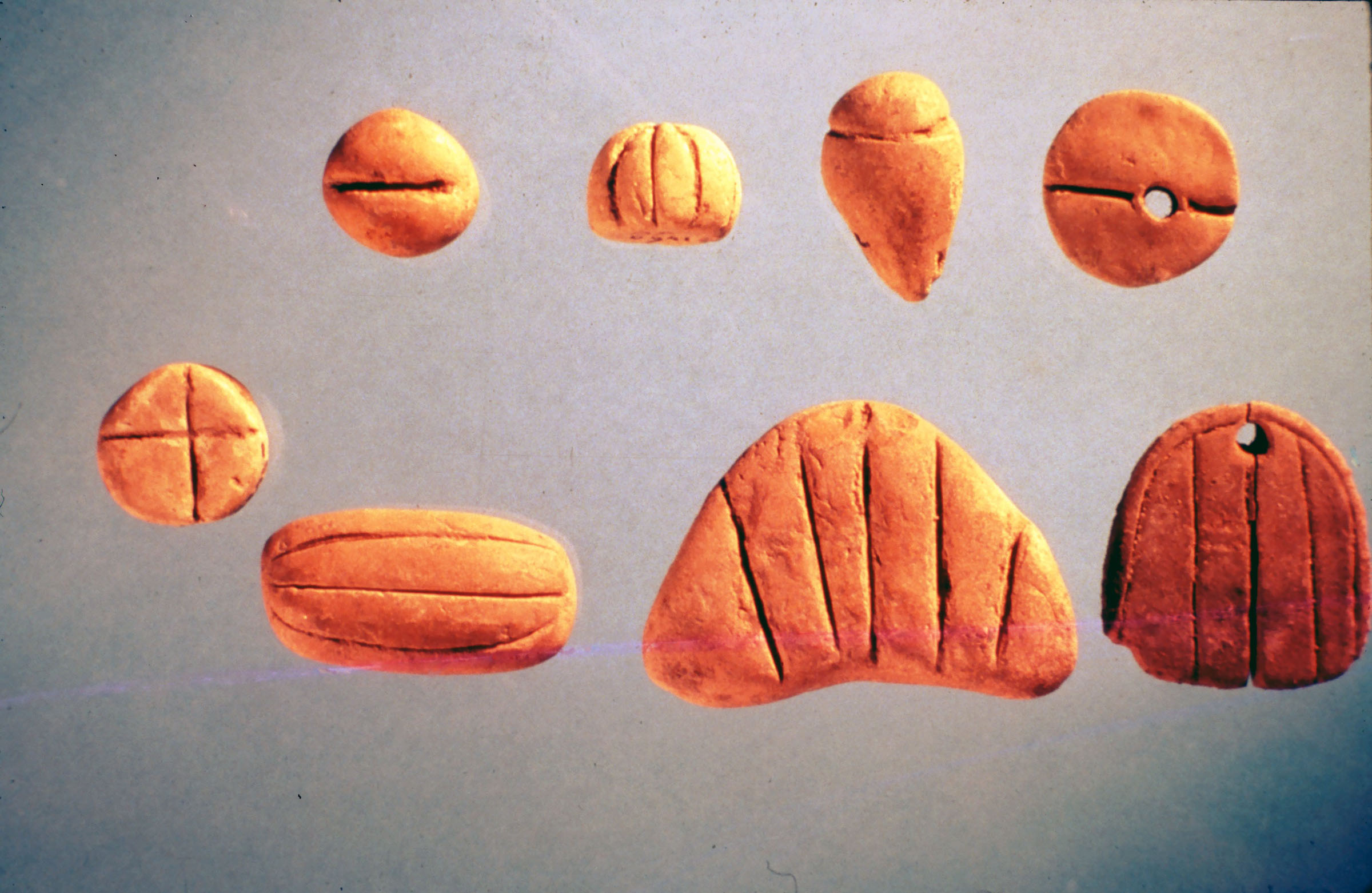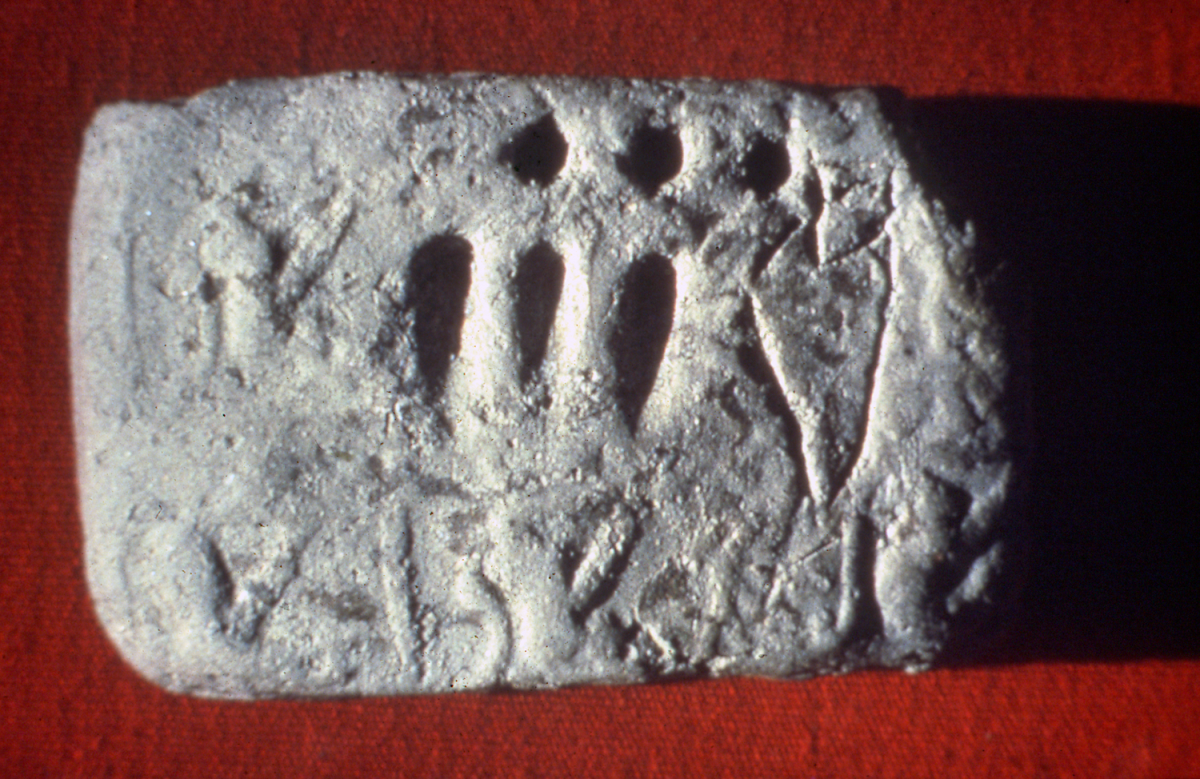By this point, humans had been drawing pictures for 30,000 years, documenting animals and people on the walls of caves.1 But those were representative drawings, depicting animals and people real or imagined. The intellectual leap of the Sumerians was the use of drawings to represent the idea of sheep—and goats and barley and everything else that needed to be recorded. These early drawings of logograms, signs that individually represent discrete objects, quickly became simplified and abstracted as scribes realized that was more efficient than drawing detailed naturalistic illustrations each time.
The idea of representing things in the physical world by manufactured signifiers has ancient antecedents in counting tokens. From the dawn of agriculture itself in 8000 BC, residents of farming communities in the Middle East used marble-sized clay tokens of various shapes—spheres, cones, discs, etc.—presumably to account for quantities of grain.

Plain tokens from Tepe Gawra, near present day Mosul, Iraq, ca. 4000 BC. (Find these locations on the map on the earlier post.) Cone, sphere, and flat disk are small, larger, and largest measures of cereals. Tetrahedron is a unit of work (one man for one day?). Courtesy the University Museum, the University of Pennsylvania, Philadelphia, linked via MAA.
These tokens were often collected inside spherical clay “envelopes” with the contents of the envelope impressed into the clay to convey its contents. Other tokens were likely strung on measures of string held by clay blobs called bullae (singular: bulla). These envelopes and bullae were often impressed by pictographic stamps called seals (more on that later) declaring their ownership or provenance.

Envelope and contents from Susa, Iran, ca. 3300 BC. Lenticular disks each stand for “a flock” (perhaps 10 animals?). The large cone is a very large measure of grain, the small cones are small measures of grain. The envelope is impressed with each token, and is also covered in lighter pictographic impressions from official cylindrical seals. Courtesy Musee du Louvre, Department des Antiquites Orientales, linked via MAA.
Four cones and a stamp impression of a deer in a forest could record four vases of wine from a particular family who carved that stamp. With the rise of cities in Mesopotamia in the 34th century BC and the explosion of traded goods as recounted earlier, a wide range of tokens in different shapes and with stylized markings on them (called complex tokens) appear.

Incised complex tokens from ancient Girsu, present day Tello, Iraq, ca. 3300 BC. Clockwise from top left: one measure of wheat, (uncertain), one jar of oil, one length of textile, one garment, one metal ingot, one length of rope, one ram. Courtesy Musee du Louvre, Department des Antiquites Orientales, linked via MAA.
In a series of papers by Denise Schmandt-Besserat,2 she explains how writing developed from the impressions of plain tokens on envelopes and drawings representing the decorative markings on the complex tokens. Impressions and drawings of tokens on a clay tablet obviated the need for the tokens themselves. If a number of sheep was represented by that number of disc tokens with crosses, a number of impressed wedges on a tablet next to a circle with a cross would more efficiently represent that number of sheep. Wedges of different sizes and shapes could stand for different quantities, a large circular impression meaning ten, for example, and the ability to use abstract numerals for quantities of anything was a major advance in the history of accounting and, as a result, writing.

Impressed and incised tablet from Godin Tepe, Iran, ca. 3100 BC. The incised sign on the right stands for a jar of oil, the circular signs stand for the abstract number 10, the wedges for 1, to represent 33 jars of oil. Courtesy Cuyler Young Jr., Royal Ontario Museum, Toronto, linked via MAA.
Not so fast, says Jean-Jacques Glassner. The earliest complex tokens appear at the same time as the first writing, he argues in his book-long critique of Schmandt-Besserat,3 thus writing couldn’t possibly have developed from them. Plus, he doesn’t see much correlation between the tokens and the signs she claims they derive from. And as for writing’s development from pictographs, so many early signs are already so stylized in their very first attestations, different from the refined likenesses in contemporaneous Mesopotamian art and occasionally totally abstract, that they don’t seem to have developed from anything at all. No, he claims, writing was actually a pure invention, and a brilliant one at that.
Next: Cuneiform
Notes
| ⇧1 | The Chauvet Cave, location of the oldest known figurative cave paintings, is the subject of an awesome documentary by Werner Herzog. |
| ⇧2 | Succinctly summarized by her in “Two Precursors of Writing: Plain and Complex Tokens” in Origins of Writing. |
| ⇧3 | The Invention of Cuneiform |